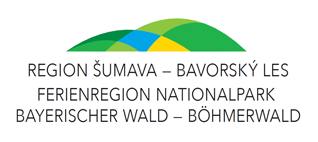1 – Horská Kvilda and The Golden Road in the Middle Ages
In the first centuries of the Golden Road and the Golden Trail’s existence, the area around Horská Kvilda was not yet permanently settled and caravans made their way through deep forest ever since exiting the last inhabited areas of Bavaria. Only in the 16th century was a building built which gave travellers some refuge. After the Thirty-years’ war there were at least four houses, inhabited by the families of Martin Švorc, Zikmund Švarc, Jiřík Stac and Jakl Mukensaumb. All four of them were traveling traders, who made their living by selling various items to Bavaria.
In the area of Horská Kvilda, the Kašperské Hory branch of the Golden Trail connected to another trade route – the Golden Road (Goldene Straße). It also went through middle Šumava and had a similar history, use, and structure of transported goods. Only this one was younger and politically and economically overseen by a Bavarian duchy.
The Golden Road led from Passau through Hals, Grafenau, Sankt Oswald and Waldhäuser (a resting place for travelling tradesmen, created in the 17th century) to deep forests below the Luzný mountain and continued on Czech land to Filipova Huť and Horská Kvilda, where it connected to the local branch of the Golden Trail. Together they continued over Zhůří and Kozí Hřbet to Kašperské Hory. The protection of the Golden Road was administered by Grafenau and the Kašperk Castle.
Area, nature, personalities, events
Numerous and large peatbogs and marshes are in some parts of Šumava the dominant cover, which is unusual. Because of this, the water here and even far below the mountains has its characteristic brown-green colour.
Because of the hydrogeological characteristics of the bedrock, which are a necessary precondition for the creation of wetland communities, a large part of the Šumava National Park is a spring region with a great potential for rainwater accumulation. This affects the water flowing regimes, often even far below the mountainous area itself, which has great implication for floods.
After the end of the Golden Road and Trail
Eventually, a village began to grow around the first houses, which fell under the administration of Kašperské Hory and numbered 19 houses by 1790. In 1840, 390 inhabitants lived here in 43 houses, there was a filial school, 2 mills and a sawmill, and around were meadows and pastures. Regarding the church, Horská Kvilda belonged to the nearby Kvilda’s parish office.
In the area of Horská Kvilda, the Kašperské Hory branch of the Golden Trail connected to another trade route – the Golden Road (Goldene Straße). It also went through middle Šumava and had a similar history, use, and structure of transported goods. Only this one was younger and politically and economically overseen by a Bavarian duchy.
The Golden Road led from Passau through Hals, Grafenau, Sankt Oswald and Waldhäuser (a resting place for travelling tradesmen, created in the 17th century) to deep forests below the Luzný mountain and continued on Czech land to Filipova Huť and Horská Kvilda, where it connected to the local branch of the Golden Trail. Together they continued over Zhůří and Kozí Hřbet to Kašperské Hory. The protection of the Golden Road was administered by Grafenau and the Kašperk Castle.
Area, nature, personalities, events
Numerous and large peatbogs and marshes are in some parts of Šumava the dominant cover, which is unusual. Because of this, the water here and even far below the mountains has its characteristic brown-green colour.
Because of the hydrogeological characteristics of the bedrock, which are a necessary precondition for the creation of wetland communities, a large part of the Šumava National Park is a spring region with a great potential for rainwater accumulation. This affects the water flowing regimes, often even far below the mountainous area itself, which has great implication for floods.
After the end of the Golden Road and Trail
Eventually, a village began to grow around the first houses, which fell under the administration of Kašperské Hory and numbered 19 houses by 1790. In 1840, 390 inhabitants lived here in 43 houses, there was a filial school, 2 mills and a sawmill, and around were meadows and pastures. Regarding the church, Horská Kvilda belonged to the nearby Kvilda’s parish office.
Today, Horská Kvilda belongs to our coldest places, sub-zero temperatures can be measured here even during summer months.
Next to the newly repaired Polauf’s Inn (today’s hotel Rankl), several valuable buildings have been preserved, for example a house with a jerkinhead roof and a belltower in Horní Otygl, by the eastern hillside of the Sokol mountain.
Next to the newly repaired Polauf’s Inn (today’s hotel Rankl), several valuable buildings have been preserved, for example a house with a jerkinhead roof and a belltower in Horní Otygl, by the eastern hillside of the Sokol mountain.

